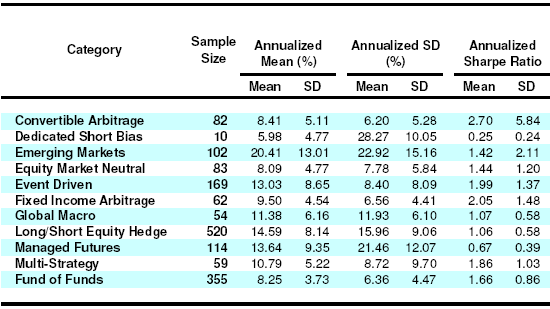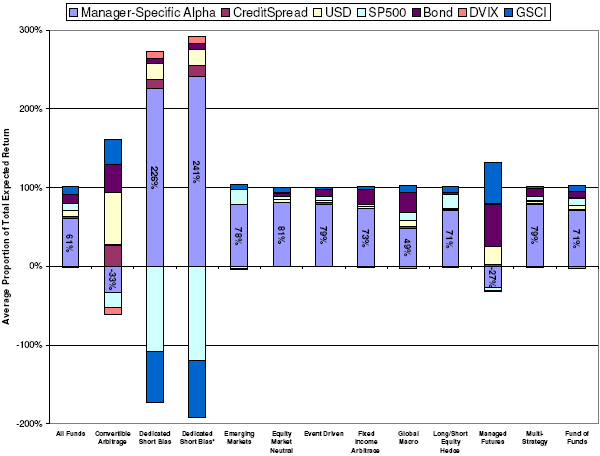Is it possible to replicate the returns of hedge funds by decomposing these returns into contributions from easily tradable risk factors? In the August 2006 draft of their paper entitled “Can Hedge-Fund Returns Be Replicated?: The Linear Case”, Jasmina Hasanhodzic and Andrew Lo investigate simple models of the performance of 11 types of hedge funds based on six risk factors (related to stocks, bonds, currencies, commodities, credit, and volatility). They then use the results for the five factors that are easily tradable to create hedge fund “clones” (synthetic hedge funds) from exchange-traded assets and derivatives in two ways: (1) applying data from the full sample period (with the associated look-ahead bias); and, (2) applying data from a rolling historical 24-month period. Using data for the period February 1986 through September 2005 on 1,610 hedge funds still active (“live”) at the end of the period, they find that:
- Hedge funds are concentrated in five categories — Long/Short Equity Hedge, Fund of Funds, Event Driven, Managed Futures and Emerging Markets — encompassing 78% of the sample. (See the table below for a full listing of categories, with aggregate performance statistics.)
- Many hedge funds assume substantial liquidity risk with their investments.
- For the entire sample of 1,610 funds, 61% of the average total return is manager-specific and 39% derives from the risk premiums of the six selected factors. However, the relationships between hedge fund returns and the six risk factors vary considerably across fund categories.
- Simple clones perform comparably to their fund counterparts in six categories: Equity Market Neutral, Global Macro, Long/Short Equity Hedge, Managed Futures, Multi-Strategy and Fund of Funds. Clones substantially underperform Event Driven and Emerging Markets counterparts.
- Clones constructed from full-sample data (with look-ahead bias) generally outperform those created with a rolling 24-month history.
- An equal-weighted portfolio of all clones produces an annualized mean return of 20.4% with an annualized standard deviation of 10.2%, yielding a Sharpe ratio of 2.00. An equal-weighted portfolio of all actual hedge funds produces an annualized mean return of 14.8% with annualized standard deviation of 9.1%, yielding a Sharpe ratio of 1.63.
The following table, taken from the paper, shows summary statistics for the hedge funds included in the study sample. Mean returns are likely overstated by a few percent due to survival bias.

The following figure, also from the paper, decomposes the overall mean returns of hedge funds in the sample by category into percentage contributions from the six selected risk factors and manager-specific alpha. For each category, contributions sum to 100%. Results show that risk factor contributions vary by fund style and that fund managers usually, but not always, add value beyond the risk premiums considered.

This paper is very clearly written, supported by many figures and tables, and explained thoroughly. The authors identify several cautions with respect to implementing hedge fund clones.
In summary, relatively simple clones based on exchange-traded instruments perform well enough to be considered as liquid, transparent, scalable and low-cost alternatives to hedge funds for many fund styles.